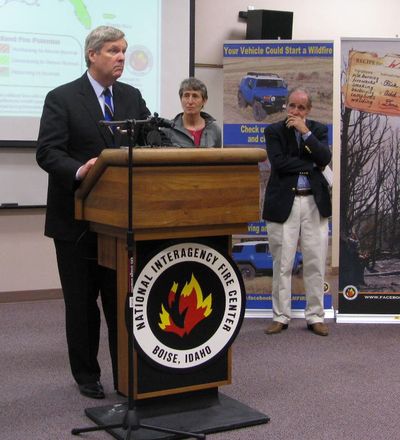Budget cuts hit as tough fire season looms

BOISE – With a “difficult” fire season looming, across-the-board budget cuts are now hitting federal firefighting agencies, meaning hundreds fewer firefighters will be deployed to fight wildfires across the nation this year.
“We’re going to be faced obviously with a difficult fire season, make no mistake about that,” U.S. Secretary of Agriculture Tom Vilsack told reporters during a Monday visit to the National Interagency Fire Center in Boise, where nationwide wildfire efforts are coordinated. “The resources are limited. Our budgets have obviously been constrained.”
The Forest Service alone will have 500 fewer firefighters this year than last year, and 50 fewer engines, Vilsack said.
Other agencies also are facing cuts, from the Bureau of Land Management to the Fish and Wildlife Service. New Interior Secretary Sally Jewell, who toured NIFC Sunday and Monday, said, “We will fight the fires and we will do them safely, but the resources will go to suppression, which is not ideal. … What you’re not doing is putting the resources in place to thoughtfully manage the landscapes for the future.”
That means things like replanting and efforts to reduce hazardous fuels will suffer.
“If we have a really tough season, we’ll fight the fires, but we may bring in more contract resources, and it’s actually a less efficient use of government money. It’ll cost us more in the end,” Jewell said. “We’ll have to take it out of other parts of our budget which are also struggling. We may be making decisions in the short run to take care of fires but in the long run not setting ourselves up for success.”
Agencies like the Forest Service and Department of Agriculture are facing not only a 5 percent across-the-board cut from sequestration, Vilsack said, but, “On top of that, Congress added … another 2.6 percent cut.” Making those cuts this far into the fiscal year, he said, means cutting “in essence 15 percent of your remaining money.”
Jewell, who started in her post five weeks ago after serving as the president and CEO of REI Inc., said, “Sequestration as a way to address the budget issue is not something I think anybody attended, but it is across the board, by line item, and therefore we don’t have the flexibility.”
U.S. Sen. Jim Risch, R-Idaho, said if catastrophic fires are burning in August and sufficient resources aren’t available, he believes Congress would come through with emergency funding.
Vilsack responded with a chuckle, “Did you get that down? Can you send that to me?”
Risch, who voted for the sequestration cuts, said, “You have got to accept the fact that there is not going to be federal spending as has happened in the past. … There’s going to be large cuts in federal spending as we go forward. What needs to be done is there has to be reform of the federal entitlement programs that are on the books. We work at that every day. … We argue about it. So far, the solution has eluded Congress, but we’ve got to keep at it.”
He said, “Until that happens, we are going to see not only in these two agencies, but we’re going to see it across the federal board, that there is going to be less spending.”
Jewell called on citizens and communities to be “fire-wise” and take steps to protect their homes, particularly those in or near the woods or wildlands, from burning in a wildfire.
“We as private citizens … play an important role,” she said, “especially in these areas where we want to live, have our cabins up in the mountains, and they are oftentimes in harm’s way.” Jewell said people need to create defensible space around homes or cabins, clear brush, trees and flammable materials, and help their neighbors do the same. “I really encourage you to do that,” she said.
This year’s fire season already has seen 13,000 fires start, but that’s actually a low number – the lowest in the last 10 years. That’s mainly because there’s been ample rain and snow across the eastern United States, limiting the fires that otherwise would normally have ignited by now in the Southeast.
But this year is expected to see above-normal risk in parts of the west, particularly the southwest, due to precipitation that’s run far below normal. Southern California has gotten only a quarter of its normal precipitation so far this year. NIFC officials said the wildfire season in West Coast states is expected to start a month earlier than normal this year as a result; fires already have been burning in southern California and even in southern Idaho.
The Inland Northwest, including the North Idaho Panhandle and much of eastern Washington, however, is likely in for a normal fire season, with the edge of the above-normal risk extending only as far north as Yakima and north-central Idaho.